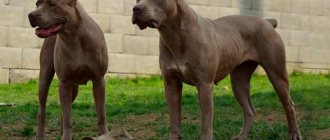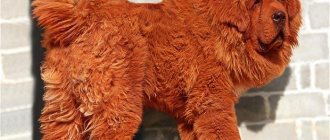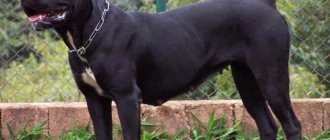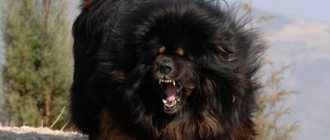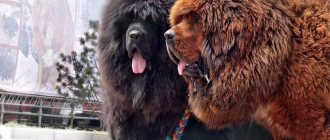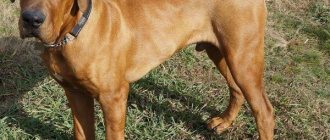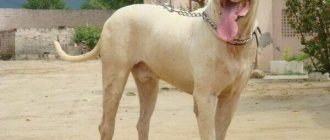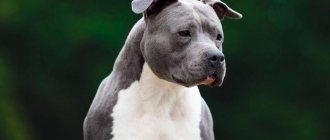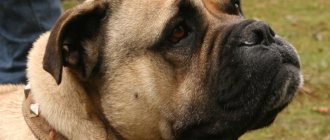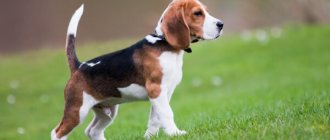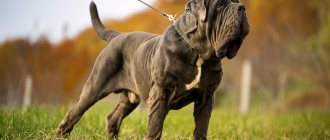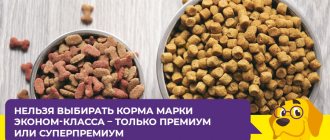The American Bandog, also known as Bandog Mastiff or simply Bandog, is another brainchild of American breeders. It is a combination of courage, confidence and calmness, a friendly attitude towards the owner and outstanding watchdog qualities. Sometimes used for boar hunting and dog fighting, in which, according to eyewitnesses, it is almost always inferior to the pit bull.
Care and maintenance
It is best to keep such a large dog outside, in a private house with a large territory.
Having a guard pet in an apartment is at least inadvisable. In such limited conditions, it will not be able to realize its protective potential. The American Bandog wants to spend all his free time from training and walking on security work, protecting his territory from strangers. It is advisable to limit all possible exits in the yard to the outside and leave the dog without a leash at night. He must live in a spacious booth located on the street. The main thing is that it is warm enough there and there are no drafts.
This pet does not require special care. He is quite strong and resistant to disease, rarely gets sick. To keep the coat healthy and smooth, it needs to be brushed regularly to remove dead hair. It is also necessary to regularly monitor the health of your ears and eyes. Such dogs most often suffer from diseases of the oral cavity, so you need to give your pet special chewing toys to clean their teeth and have them examined.
Mating
The first mating is carried out no earlier than 2 years. It can be difficult to choose a partner; the breed is recognized by very few associations, and accordingly, the origin of many animals is difficult to establish.
It is better to contact trusted nurseries whose lines will be of interest to improve the parameters of a particular dog. The nearest Bandog breeders are located in Ukraine, Germany and Greece.
If an animal is used that is not from a nursery, then it is imperative to check its pedigree and exhibition achievements. Parents must match the breeds of one of the 3 existing areas of selection.
The female and male must demonstrate excellent health and be free of genetic diseases. Partners must be treated for helminths before mating; this is prohibited during pregnancy. Mating is usually carried out on the male’s territory, 2-3 times with a break of 24 hours. After this, you can expect the appearance of offspring.
Read a detailed article on the topic: “Everything you need to know about breeding dogs: appropriate age, what to do if it doesn’t work out, rules and tips.”
Content
As a representative of a guard breed, the pet has impressive body parameters and great activity. Therefore, the best place for it to live would be a country house: you can set up an enclosure on its territory, and keep the animal in a warm room in winter. The dog needs to be able to run freely, so a backyard area is ideal. It is not recommended to keep a bandog in an apartment, as well as to put it on a chain. Although the name of the breed translates as “chain dog,” this equipment should not be used on a pet: it will be very difficult for the owner to establish contact with him due to increasing viciousness and aggression.
When keeping a pet in an enclosure, it is necessary to walk it every day. Additionally, it is worth building him an insulated kennel, since short hair does not allow the dog to withstand the cold. It is imperative to let the dog out so that he can release the accumulated energy - this will allow him to become calmer and more balanced. Activity has a positive effect on your pet’s health and serves as a preventive measure for musculoskeletal diseases.
Walking the “American” should last a total of 2 hours daily and include the following mandatory types of physical activity:
- Overcoming obstacles.
- Workout.
- Jogging.
- Games.
Sufficient mental and physical activity will allow the animal to be a model, and the owner to establish lasting contact with it. It’s very good to just let the dog out into nature outside the city, where he can run around. In public places, walking should only be done on a short leash and with a muzzle.
Feeding
Dog breeders recommend using natural food, the calorie content of which is 4800 kcal per day. An adult dog should be fed twice a day
It is important not to overfeed your pet, so as not to provoke problems with the liver, heart and excess weight. The diet consists of:
| Recommended diet | |
| Lean meat | Beef |
| Kash | |
| Fruit | |
| Vegetables | |
| Dairy products | Cottage cheese |
| eggs | Definitely hard-boiled |
| Sea fish | Boiled |
It is good to feed the “American” soup with cereals and vegetables - not too liquid, close to the consistency of sour cream, so as not to cause the dog’s belly to sag. It is useful to give your pet bones to strengthen his teeth. Clean water should always be freely available.
The owner needs to place bowls no higher than the level of the animal’s chest, so as not to provoke curvature of the spine. As soon as the dog has finished his meal, it is necessary to remove the food bowl.
How to care?
If you take proper care of your dog, it will live much longer.
The dog's coat is coarse and short, so it is not visible when shedding in the yard. As for apartment living conditions, the owner is required to comb the dog twice a year and carry out wet cleaning every day until the coat is replaced. For combing, pet stores sell special brushes that quickly remove dead hair, thereby reducing shedding time. Moreover, grooming is a good prevention of skin problems.
It is not often necessary to bathe the animal. If it is kept in the yard, then you can go to the pond several times a month, where the dog can swim, or give it a shower with a hose. In an apartment, the need for water procedures arises when the dog is very dirty. Use only specialized shampoo for washing, the water should be warm. After the animal is dried well, you can dry the fur with a hairdryer, although bandogs are not prone to colds and can cope with slight hypothermia.
The eyes and ears of the animal require special attention, since they suffer most often. When kept outdoors, it is necessary to clean them of dirt every week and make sure that there are no ticks in the ears and that the eyes do not become sour. Cleanliness plays a decisive role in the formation of a dog’s keen sense of smell and vision.
If possible, experts advise regularly visiting a veterinarian, who can detect problems with the dog’s musculoskeletal system in advance and eliminate them. Long and active walks are essential for the breed.
When walking in the city, you should avoid areas with a lot of people, as they can irritate the dog and he will begin to behave aggressively. In large cities there are already equipped special closed areas for animals. On their territory you can use exercise equipment for free. Such activities help keep your dog in good physical shape.
Bandog vaccination is carried out at a certain period
It is especially important to exclude the possibility of infection with diseases such as:
- plague;
- enteritis;
- hepatitis;
- parainfluenza;
- rabies;
- coronavirus;
- leptospirosis;
- trichophytosis.
The first vaccinations are given in the nursery at the age of 2 months. If your dog is left with a domestic litter, you should contact your veterinarian. It is forbidden to wash, take the dog out into the fresh air and overfeed the dog. Immunity will develop only within 12 days after vaccination.
The owner is required to pay maximum attention to his pet so that he can more easily tolerate the vaccination. Don't be surprised if your puppy has a fever; this is a normal reaction to the first vaccine. Often the dog becomes lethargic, inactive, and develops diarrhea.
Three weeks later, a second vaccination is given using the same drug. The dog tolerates the next vaccination more easily, but it still needs to be protected from other animals for 12 days. Any walks are strictly prohibited; after the specified period, the quarantine is lifted.
At the age of 6 months, Bandogu is vaccinated against rabies and other diseases. The vaccination is comprehensive, but it is canceled if the change of teeth from milk to molars is still ongoing. After another six months, the procedure is repeated, but for other viruses. After each year, the dog breeder must take the dog to the veterinarian so that he can repeat the vaccination, so the bandog will be protected from diseases that can kill him ahead of time.
People without appropriate education cannot vaccinate themselves; this is done by qualified doctors. Before the procedure, a number of preliminary actions must be carried out:
- external examination of the puppy;
- measuring body temperature.
Only when everything is normal is the vaccine administered to the animal. The injection site can be the animal's thigh or scruff. All procedures are included in the veterinary passport, and the date is also written there so that the owner can know when the next vaccination date comes.
With proper care, bandogs have excellent health. All problems arise when the owner stops providing the dog with quality nutrition, underfeeds or overfeeds the pet. In such cases, one has to deal with joint dysplasia, obesity, malfunction of internal organs, and cancer.
Hygiene
You don't need to bathe your pit bull puppy often. Exceptions are cases when he gets dirty in the mud or swims in a puddle. If the puppy is white, or just light-colored, it will be more noticeable when it's time for a bath.
When it comes to bath procedures, certain rules are followed:
During and after bathing, make sure that the puppy is not exposed to a draft.
To maintain oral hygiene, you need to properly care for your teeth - for this you use a special paste and a brush, similar to a human one, or one that is put on your finger. The dog is gradually accustomed to this procedure, always starting with the far teeth on the outside.
The puppy's eyes should always be clean. If discharge appears, the eyes are washed or treated with special medications. If the discharge is permanent, consult a doctor.
Ears are cleaned every week. To do this, use a cotton swab and ear cleaner. It is important to regularly check your dog for ticks - they like to “cling” closer to the ears, jaw and neck.
Important! Under no circumstances should you use saline solutions or products containing alcohol to clean your ears.
Origin story
It is believed that the Bandog dog breed originates from good old England, where pets with a similar exterior were used as home guards.
Because of their stern disposition and frightening appearance, they were kept on a strong chain during the daytime and only allowed to roam freely at night. They were called that - bandog (chain dog). With the advent of a new hobby - dog fighting, animals of this type were attracted as participants in this cruel entertainment.
Bandog is a serious and beautiful breed
Unfulfilled hopes
There are two main failures associated with the development of this breed. The first example of an unfulfilled dream is the desire of the American veterinarian Swinford to breed the ideal breed of watchdog.
Having become interested in animals that were used for protection in old England, he tried to breed a breed through crossbreeding, which, despite its threatening appearance and protective qualities, was easy to train.
Despite the fact that the Bandog breed as it is known today is named after Swinford, the veterinarian’s dream never came true. He never succeeded in breeding the ideal watchdog. After the death of the doctor, the business was continued by his followers and other breeders. Similar varieties have been bred, for example the Australian bandog.
After Swinford's death, interest in bandogs did not fade away. Many breeders tried to improve the breed and crossed more and more new breeds of fighting dogs with each other. The hope of many was to breed the most suitable species for participation in dog fighting, but this dream was also not allowed to come true.
Interesting! The Bandogs completely refused to fight and enter the ring. Despite their power, they were inferior in strength to some fighting breeds.
The future of the breed
At the moment, bandogs remain unrecognized by the world. The breed is not considered purebred and is even prohibited for breeding in many countries. But work on improvement has not stopped.
A few breeders continue to work on breeding more obedient and balanced Bandogs. There are not many nurseries that are engaged in breeding and continuing the Swinford business.
What other dog breeds are on the “dangerous list” along with pit bull mastiffs?
From January 1, 2022, the Federal Law “On the Responsible Treatment of Animals and on Amendments to Certain Legislative Acts of the Russian Federation” dated December 27, 2018 N 498-FZ comes into full force. According to this legislative act (Article 13, paragraph 6), dogs included in the “List of Potentially Dangerous Breeds” must be walked only with a muzzle and on a leash. The only place where you do not need to adhere to this rule is the territory belonging to the dog’s owner. This area should be fenced with a solid fence, and at the entrance there should be a sign “Beware, angry dog!”
A total of twelve dog breeds are included in this list; the thirteenth item includes mixed breeds of the above breeds. The Pit Bull Mastiff is in eleventh position on this list.
List of potentially dangerous dogs:
- Akbash.
- American Bandog.
- Ambuldog.
- Brazilian Bulldog.
- Bully Kutta.
- Purebred Alapaha Bulldog (Otto).
- Bandog.
- Wolf-dog hybrids.
- Wolfdog, wolf hybrid.
- Gul dong.
- Pitbull mastiff.
- North Caucasian dog.
- Mixed dogs from points 1-12.
Representatives of the RKF have a number of questions for legislators; not all breeds actually exist, not all are found in our country, but the rules are the rules. Owners of Pitbull Mastiff mixes will need to comply. Violation of this Law provides for liability.
Education and training
Bandogs are considered a difficult and dangerous breed. Maximum attention must be paid to the upbringing and training of these dogs. It is necessary to raise a puppy from a very young age. Only in this case can you avoid mistakes and troubles associated with them in the future.
Important! A fighting breed dog that does not know how to communicate with relatives and strangers poses a great danger
You need to train your dog from a young age.
As soon as age allows, you need to start training
Given the complexity of the Bandog's character and leadership qualities, special attention should be paid to obedience commands. If problems arise, it is better to contact a professional
Beginning dog breeders may not have enough experience and knowledge to raise and train, so it is better for beginners to refrain from purchasing a puppy of this breed. It is also not recommended for families with children to have such a dog.
Métis health
All large dogs live less than miniature ones. Pit bull and mastiff mixes are large in size - their average life expectancy is 8-12 years. Some genetic and non-hereditary health problems present in this breed may affect this duration.
- Hip dysplasia.
- Diabetes.
- Hypothyroidism.
- Subaortic stenosis.
- Progressive retinal atrophy.
- Chronic renal failure.
Puppy selection criteria
Bandogs are bred mainly in the USA. There are a few breeders in Greece, Brazil, Slovakia and a number of other countries.
If you want to choose an American Bandog puppy, you should carefully decide on the breeder. While representatives of other dog breeds have more or less typical appearance and standards, bandogs, if the parents are incorrectly selected, can turn out to be defective and have undesirable qualities from a social and physical point of view.
In the process of breeding chain dogs, breeders use different breeds, depending on the expected result. Some are trying to breed a guard dog for hunting, others want to get a bodyguard dog, and others are breeding fighting animals. In this case, the owner should look not just for an enthusiastic breeder who dreams of getting a certain color, but rather for a competent professional with knowledge, experience and vague achievements in this area.
As for breed standards, it seems that they simply do not exist for the Bandog. By fitting a dog into a certain framework, there is a risk of destroying their working qualities, and these are valued in the first place.
Watch this video on YouTube
Appearance
The American Bandog inherits the appearance of the original breeds, and since they can be different, Bandogs from different kennels look different. Usually breeders determine their desired type and support it with a selection of sires.
It is customary for Bandogs to have their ears and/or tails docked short.
As a rule, bandogs are large, powerful dogs, which, despite their size, have extraordinary mobility, agility and enormous physical strength, prominent muscles and short coats of different colors. White is considered undesirable. The average height at the withers of a bandog is 60-65 cm, weight usually ranges from 40 to 65 kg.
Australian Bandog Pregnancy and Birth
From the day of the first mating to the birth itself, 56 to 72 days pass. It is advisable to note the day of mating in order to know how long the dogs are pregnant. Too early and too late births most often lead to the death of the litter, so in both of the above cases it is necessary to seek help from a qualified veterinarian. The gestation period in dogs may be shortened due to the small number of offspring.
Typically, young females produce fewer puppies.
The litter size increases when the dog reaches 3-4 years of age, then decreases again. The duration of pregnancy in dogs is not very long; it is not so easy to determine that a dog is pregnant.
Obvious signs of pregnancy in dogs appear at quite late stages. Neither palpation nor the appearance of the pet at an early stage of pregnancy will tell the owner whether the mated bitch is expecting offspring or not. The first signs concern not so much the external appearance as the mental state, and therefore the behavior of the pregnant bitch. The dog, as a rule, becomes calmer, shows affection more often and demands affection from others. Sometimes the animal may not even seem completely healthy.
If the pregnancy is progressing normally, the specialist can establish pregnancy by palpation in the third week. After a month, the dog’s belly noticeably enlarges, and in the fifth week the mammary glands swell and lighten. Shortly before giving birth, the bitch's belly drops. A characteristic sign of approaching labor is abundant discharge from the loop, yellowish or greenish in color.
Also prepare a “maternity kit” so that everything you need is at hand, it should include:
- old duvet covers or large disposable diapers (60*90), on which the bitch will whelp (disposable diapers are preferable - less washing and more cleanliness);
- a lot of small soft rags ironed with a hot iron from old bedding (to dry puppies);
- sterile gauze wipes (usually unnecessary, the puppy’s mouth is dried with a piece of cloth, into which, in fact, the puppy is received);
- a pen, a notebook, scales and thick woolen threads or ribbons (it is better to use floss, because the bitch simply licks and removes woolen threads);
- afterbirth bowl;
- a box or basin for puppies with a heating pad (wrapped in a diaper) - this is in case the bitch behaves restlessly during childbirth and there is a risk of losing puppies... the best option is a bitch giving birth with puppies at the nipples;
- sterile scissors and a medical clamp (it is not necessary to boil; at the onset of labor, place in a jar with any alcohol);
- milk chocolate bar;
- an antiseptic, preferably a spray (Aluminium, Xidicol, Septonex) for treating the umbilical cord.
And also a puppy resuscitation kit:
- cordiamine to stimulate cardiac activity (a drop on the tongue of a newborn);
- an oxygen canister (to give a weak puppy a chance to breathe), costs about 400 rubles in pharmacies;
- small rubber heating pad;
- a small enema for suctioning mucus from the mouth of a very weak puppy.
As for medications, during a normal birth they will not be needed, and if you had to resort to the help of a veterinarian, then he will have the necessary kit. Just in case, you can keep in stock No-shpu in ampoules, glucose 5% solution for infusion; calcium gluconate (a box, may be useful after childbirth).
You will also need a watch to mark the time of birth of the puppies and a notepad to record the details of the whelping (they will come in handy in the future), with your veterinarian's phone number displayed in a visible place. It's also great to have a scale for weighing newborn puppies. The puppy's birth weight, among other whelping details, should also be recorded in a notebook.
Bitches usually whelp between 58 and 63 days. Large litters are born earlier, and small ones a little later.
In the last days before whelping, you need to monitor the bitch’s body temperature. The normal temperature measured in the anus is about 38.5°C. Two days before giving birth, the bitch's temperature usually drops to 37°C or even lower. But since this does not always happen, you need to be attentive to all other signs of impending whelping. And yet, more often than not, if the temperature remains normal, then the bitch is unlikely to whelp in the next 24 hours.
Before whelping, it is good to give the bitch a mild laxative to help her cleanse her intestines.
It is better if, 2-3 days before the expected birth, you call a veterinarian or clinic, warning in advance about a possible call; in any case, the necessary phone numbers should be in a visible place.
Buy an American Bandog
Bandogs are currently bred by many dog breeders with varying levels of experience in this matter. Bandogs, like any other breed of dog, are capable of absorbing not only the best, but also the worst qualities of their parents, so the puppy buyer must be very well aware of the breeder’s experience and his desire to improve the breed’s characteristics in order to eliminate negative character traits.
What to pay attention to
If you want to purchase a Bandog puppy, it is very important not to be lazy and visit the breeder of such dogs several times in order to get acquainted with the parents of the potential pet. A Bandog dog must be chosen very carefully:
- the puppy should not show excessive aggressiveness or cowardice;
- the puppy must have clean skin, ears and eyes;
- the puppy should not be apathetic;
- The puppy's appearance must fully comply with breed standards.
It is very important to first make sure that all accompanying documents are available and carefully read them
American Bandog dog price
The mental stability indicators of an American Bandog puppy directly depend on the level of purebred, so the cost of a good dog cannot be too low. The average price of a month-old puppy of this breed in a nursery is about 300-400 dollars.
Distinctive features
Bandoggie inherits characteristics characteristic of its parents. Therefore, dogs from different kennels differ from each other.
In general, the breed is characterized by the following features:
- The head is massive, with a visible stop. The muzzle is elongated, not narrowed.
- The nose is often black and well developed.
- The eyes are small, slanted, located far from each other, the iris is dark in color.
- The neck is powerful, muscular, and of medium length.
- The ears are drooping and usually cropped into a triangular shape.
- The tail is of standard length, tapered to the tip, hangs down when calm, and never curls over the back.
- The body is strong, with developed muscles, massive bones, the back is straight. The chest is very wide and deep, the ribs are pronounced, the stomach is tucked.
- The legs are of medium length, heavy-boned, strong, well-defined.
- The coat is hard, straight, and short in length. Almost any color, but a pure white shade is undesirable. There are usually light markings on the legs.
Features of character and behavior
Representatives of the breed are distinguished by:
- Activity;
- Energy;
- Devotion to the owner;
- High security capabilities;
- Distrust of strangers.
Advantages
- Representatives of this breed are born watchdogs and have a pronounced territorial instinct.
- Dogs are fearless and will defend theirs to the last.
- They carefully monitor strangers, analyze their behavior and make sure to stop all unwanted actions. Although, most often, one frightening appearance of an animal is enough to eliminate thoughts of attack or theft. Despite the formidable exterior, with proper upbringing the dog is quite balanced and does not show unmotivated aggression towards strangers.
- They are devoted to their owner, strive to please him, unlike other representatives of working and guard dogs, they do not try to dominate. They usually treat other family members evenly; they can get along with children, but they will not tolerate intrusiveness and disrespect towards them.
- Bandogs study everything new with interest, love to play, and are trainable. Dogs of this breed are silent and rarely speak, especially without reason. They have a high pain threshold, dexterity, high intelligence, can intuitively determine a person’s intentions, and often develop a line of behavior on their own.
Flaws
Bandoggies will find it difficult to tolerate being around other animals, especially those of equal size. Living with cats and dogs is only possible if they were raised together from childhood. A pronounced protective instinct, in the absence of education, can result in aggression towards strangers, uncontrollability and imbalance, which, combined with some willfulness in decision-making and the large size of the dog, can lead to negative consequences. Before an attack they do not bark in warning, they attack immediately. Lack of physical and intellectual stress will lead to destruction in the house, nervousness of the animal and increased excitability
Therefore, it is important to give the dog an outlet for energy. Due to their physique and the characteristics of the central nervous system, representatives of the breed quickly become excited, violently attack an intruder or other animal, but are capable of maintaining this level of activity for a short time. Then the dogs get tired and their engagement levels drop. Bandog is stubborn and self-willed; he will not do what he does not like and will not tolerate rough treatment.
When raising children, you need to be firm and find a special approach.
Spanish Mastiff
The Spaniard is a giant dog that can scare a person with just its appearance. It is known about the Spanish Mastiff breed that they are quite freedom-loving and devoted to their family. The independent character of the dog needs a strong, self-confident owner.
Mountain dogs are used to making decisions on their own. There is no need for external guidance. An owner who has no authority will simply be ignored. Therefore, this breed is not at all suitable for novice breeders.
The animal is massive and stocky. He has a huge head, a large deep muzzle, and powerful jaws. Full lips and a characteristic pendant of folds are a feature of all dogs of this breed. The eyes are small, the look is good-natured and frivolous. However, first impressions are deceiving. Behind the indifferent look lies observation and excellent erudition.
Colors:
- light straw;
- pale yellow;
- bright red;
- black;
- brindle.
A few white markings on the chest and legs are allowed.
The gender of dogs is clearly expressed. Males reach 85 cm at the withers, females - 20 cm lower. The weight of males varies at 60-70 kg, females - 40-55 kg. Despite the massiveness of the body, the mastiff moves easily and gracefully.
Story
The term BANDOG or BANDOGGE originated in the 1250s and 1300s in Middle England and meant a mastiff-like dog that was chained during the day and released at night to guard territories. In 1576, Johannes Caius published a book about English dogs, in which he described the Bandog as a huge, purposeful, dangerous, very aggressive and extremely active dog with a massive body. The first Bandogs may have come from dogs that participated in bullfighting, from guard mastiffs, or from crossbreeding of dog breeds that participated in the Crusade. William Harrison, in his 1586 description of England, mentions: “The Bandogge is a huge dog, stubborn, somewhat ugly, terrible, very energetic, fearsome, of a very fierce disposition.” Perhaps the word BANDOGGI came from the powerful chains with which these dogs were held. In 1576 Dr. Caius states that "Bandoggy is useful both for scaring foxes and badgers from pastures, and for keeping an eye on cattle in meadows and pastures, and in some cases for biting a bull on the ear if required." Old Bandogs were definitely working dogs, of various crossbreeds and sizes. Typically these dogs were rough-coated hunting dogs, fighters, and guard dogs.
The first modern bandogs were bred in the early 70s of the 20th century by an American veterinarian named Swinford. Dogs of this type are often called Swinford Bandog or American Mastiff. Joe Lucero made a significant contribution to the development of the modern Bandog breed. Lucero called his dogs American Bandoggy Mastiffs. There are other names for the breed, but the Lucero breeding line is the most outstanding due to its stable character and working qualities. Most breeders used the American Pitbull Terrier or the American Staffordshire Terrier and the Neapolitan Mastiff.
Reviews
Semyon Petrovich, 62 years old All his life he dreamed of a huge dog that he could safely entrust with guarding the territory. I was choosing between an Alabai, a German Shepherd and a “Caucasian”. Fortunately, there are a lot of familiar “dog lovers”. We discussed with them what was best. They advised me to try adopting a bullmastiff. At first I wasn't happy. The puppy grew up looking like a boxer, he was distinguished by fussiness, even some kind of cowardice. It just seemed that way to me. Alfred grew up quickly and, surprisingly, being in the junior group, began to show character. Any rustle, sound, or extraneous noise caused an immediate reaction from him. But one thing appeared: he sleeps during the day, “works” at night. Not a single car could pass by the site. I’m not saying that Alik is the threat of all hooligans. If he hears a loud conversation or laughter outside the gate, he reacts immediately. He's sharp as a bullet. I encountered a problem that turned out to be insoluble. At times, the dog is simply attacked by wild laziness. Here is your faithful guard. But he grew into a proud, independent dog. I really love his face, even though he is a rare lazy person.
Valentina, 42 years old We have Bordeaux style. Now Vetka is 8 years old. I admit that at first I was openly afraid of her. The kids took it for fun and then gave it to my husband and me. I had to educate them because they didn’t have time to go for long walks. I’ll say right away that Vetochka eats very well. It seems to me that my husband and I do not consume a lot of food there. We spend the summer at the dacha and no one can enter the territory, which we are happy about. There were never any problems with obedience. Always follows commands and understands all gestures. The intelligence is amazing. She loves to lie around, and I scold her for it. Imagine, you are walking somewhere around the house, and there lies a beautiful woman weighing 50 kg. with excess and snoring. And so on all the time. But he just rushes into the street. Personally, I am afraid every time that she will simply dump me. It’s good that we walk without a leash, but no one will approach.
History of the breed
The American Bandog breed is one of the youngest. Selection and breeding of these dogs has been carried out only since the 70s of the 20th century. This was started by the veterinarian Swinford, which is why the dogs can also sometimes be called Swinford's bandogs.
To obtain the breed in its modern form, the American Pit Bull Terrier and the American Staffordshire Terrier were initially crossed. In addition, later there were additions of blood from the American Bulldog, Neapolitan Mastiff, Dogue de Bordeaux, Bullmastiff, Fila Brasileiro and Presa Canario. Depending on the breed line, the admixture of one or another blood may appear to a greater or lesser extent. The main requirement is that the animal meets currently accepted standards. The American Bandog, a photo of which can be found on the Internet, looks similar to all of its ancestors.
The ancestors of the breed are mastiff-like dogs brought to America from England by colonists. Animals were used for fighting, which was then common in Europe. This entertainment has taken root in America so much that dog breeders began to actively work on breeding new fighting dogs that would be stronger and more aggressive, as well as more resistant to various types of pain.
The main purpose of the breed during its creation was considered to be the use of animals for gladiator dog fights in pits, which was widespread in the Northeast of the country, and primarily in New York and New Jersey. However, this remained only a dream of breeders and breeders, since the resulting dog turned out to be unsuitable for such a purpose, inferior in its fighting qualities to other breeds, including the pit bull and Staffordshire terrier. As a result, the bandogs suffered one defeat after another, without bringing any income to their owners. However, another use was quickly found for the new breed: the dogs began to be used as guard dogs, and they showed their best performance. It was also discovered that they perfectly defend their territory from wild animals, fearlessly attacking wolves, foxes and badgers. Today, the American Bandog, thanks to its courage and devotion to its owner, is also a bodyguard. These dogs are often used as service dogs in US law enforcement agencies.
Today, the breed is in the process of development and its formation, which is why it is classified as not yet recognized. In many countries, the breeding and keeping of its representatives is completely prohibited, since the dog is considered one of the most dangerous. Breeders continue to work on creating an animal that would combine ideal guarding and fighting qualities and would be recognized internationally.
Features of the breed and character of the Bandog
The Bandog's pedigree includes the American Pit Bull Terrier, the Staffordshire Terrier and the Neapolitan Mastiff, famous since the Crusade. The breed was originally created for dog fighting and hunting large animals.
The inherited agility, fearlessness, tenacity inherent in the pit bull, power, extraordinary muscles, and guardian instinct from the Neapolitan mastiff converged in the appearance and nature of the bandog. His activity, turning into rage, distinguished the dog during the period of bloodthirsty fights.
In the photo there is a dog of the Bandog breed
The gladiator dog was fierce, merciless and uncontrollable in battles with bulls and relatives. But after a hurricane attack, the dog succumbed to the growing power of the pit bull terrier.
The structure of the body and the characteristics of the nervous system at a certain stage prevented the continuation of the fight. So the breeders’ idea of a killer dog was not always justified.
Unlike its American counterpart, the Australian Bandog was bred exclusively for peaceful purposes: for protection, guard work and to serve as a reliable companion to active owners.
The time has come for bans on dog fighting, the retraining of the breed for security purposes has begun - to protect houses and property. Foxes and badgers often visited farmers' homesteads to steal away small livestock.
Dealing with them is not easy, since in a threat situation the animals are unusually aggressive, and not every dog is able to defeat these thieves. Bandog did an excellent job with this task.
Until today, strong-willed dogs are used as guards, companions, bodyguards, and in special cases they are trained to work in law enforcement agencies.
The owner of a bandog can only be an experienced dog breeder who is able to cultivate the best qualities of the four-legged dog and manage the difficult character of the pet. The main feature of the breed is its protective instincts, the ability to distinguish a person’s dangerous intentions from playful, playful ones, and excellent instincts.
Apartment burglars are very afraid of such dogs. She won’t bark outside the door or give away her presence. But he will not allow a stranger to leave the house. In practice, there were tragic cases of reprisals against thieves.
Unlike many fighting breeds, the Bandog does not strive for leadership; he feels like a member of the pack in which he grew up. Recognizes any other animals if they grew up with him from puppyhood.
Respects the strength and authority of the leader in the family, and treats others evenly. He won’t allow you to play with yourself if he doesn’t want to frolic. He will not tolerate bullying, even from his beloved owner or child.
French Mastiff
The French Mastiff is often referred to as the Dogue de Bordeaux. The difference between the dog is its unusual physique. The dog is squat, but at the same time its muscles are quite developed. The dog has a dissatisfied look. However, the expression of irritation hides a good-natured and sociable nature. As long as the dog and its owner are not in danger, the mastiff behaves complacently. If there is danger, the pet will be alert and concentrated.
At the withers, a mastiff can grow up to 70 cm. Its body is large, its head is a match. The forehead is wide and flat. The muzzle is short, wide and wrinkled. The ears are small and drooping. The chest is massive, the neck is thick. The front end is very powerful. The legs are shorter in front than in the back. The limbs are parallel. Color ranges from light brown to reddish. The coat is very thick, dense, but short. The price of a French Mastiff puppy depends on the place of purchase, pedigree, and compliance with standards. A dog of this breed costs around 500-1000 dollars.
